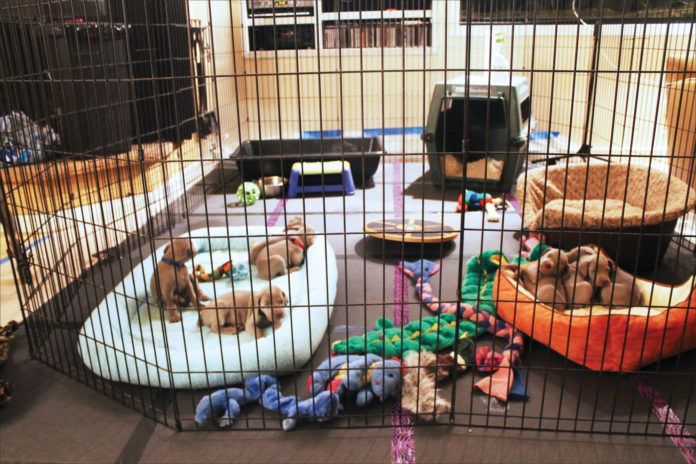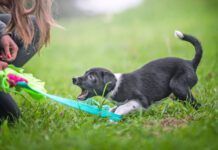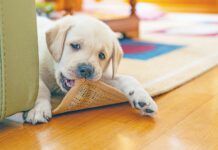Cute is not the first word you reach for when describing newborn puppies. Born unable to hear or see, with smushed-in faces and twitchy little bodies, they look for all the world like diminutive aliens. Detached and distant visitors from another planet, they are in their own orbit, apparently seeking only warmth, milk, and the rough caress of their mother’s tongue. Nothing, of course, could be further from the truth.
From the time they are born, puppies are gathering, processing, and synthesizing huge amounts of information from the world around them. And although it is pretty well accepted that puppies need intense socialization when they leave their human caretakers for their forever homes, relatively little is said about the importance of thoughtful, consistent exposure to new stimuli in their first eight weeks of life.
Some forward-thinking breeders, however, have concluded that while temperament is certainly hereditary, early experience can dramatically modify brain development, stress tolerance, stability, and reactivity. Even the fundamentals of potty training, attentiveness to a handler, and a recall can be programmed at what some might consider an absurdly young age.
Longtime judge, breeder, and lecturer Pat Hastings of Aloha, Oregon, author of Another Piece of the Puzzle: Puppy Development (Dogfolk Enterprises, 2004), has seen firsthand the power that environment can exert over genetics.
“I believe very strongly that you are born with your temperament, but you can modify behavior,” she says.
“I really believe that with puppies, nurture is much more important than nature. I just see so much of it.”
Hastings is sought after for her puppy evaluations, in which she assesses whole litters of eight-week-olds, not just for conformation (physical structure) but also temperament. A case in point is a litter of Parson Russell Terriers she recently evaluated for a breeder who spends a great deal of effort interacting with and socializing her puppies.
In addition to her eight puppies, the breeder also brought one along that was three days older and had all the genetic background to be identical to her other puppies: The breeder had bred the puppy’s mother, and the sire was all her pedigree, too. But the puppy had been whelped and reared by someone else, and hadn’t been exposed to the same handling or socialization that her well-adjusted puppies had. “You would think it was a different breed,” Hastings says.
While reputable breeders breed with a specific goal in mind – their next great show dog or brood bitch, that future master hunter or agility star – an overarching priority should be producing stable, tractable temperaments, regardless of a puppy’s final destination.
“It’s very important to end up with really good pets,” Hastings says.
To that end, here are some of the techniques progressive breeders use to help maximize the neurological and behavioral development of their little explorers in fur suits. They share this common philosophy: Providing safe and fun experiences for puppies – to expand their horizons, stretch their bodies and minds, and learn that novelty brings good things – is the best investment breeders can make in their pups’ first eight weeks.
Never Too Early
Many breeders enthusiastically recommend a program of early neurological stimulation based on the “Bio Sensor” or “Super Dog” program developed by the United States military in the 1970s. (There are differing opinions about the success of the military program, and even who came up with the guidelines, but nonetheless, many breeders swear by them.) Daily from the ages of 3 to 16 days, puppies are exposed to these five exercises for three to five seconds each. All the exercises are intended to safely and briefly expose the puppy to a period of physical stress from which he can easily recover.
– Holding the puppy in one hand, the handler gently tickles between the pup’s toes with a cotton-tipped swab.
– Grasping the puppy with both hands, the handler holds the puppy perpendicular to the ground (that is, with his head held upward, directly above his tail).
– Again holding the puppy with both hands, the handler holds the puppy upside down, with his head pointing toward the ground.
– The handler holds the puppy on his back in the palm of both hands, so he is permitted to sleep.
– Finally, the handler puts the puppy, feet down, on a damp towel that has been refrigerated for at least five minutes, but does not restrain the puppy from moving.
– Breeders who do this early neurological stimulation say their puppies are better adjusted, with greater stress tolerance and reduced frustration levels when confronted with obstacles.
“I have seen unbelievable results with it,” Hastings adds. “I probably know 40 breeders who have done it to half their litter to see what the difference was – and the difference was mind-boggling.”
– Hastings points to her own breed, the Doberman Pinscher, as an example. “Dobies are working dogs, but they don’t work in bad weather – they don’t do cold or rain,” she laughs. “But I have never seen a Dobie puppy whose breeder did early stimulation that had any issue with weather.”
– Hastings stresses, however, that breeders should not go overboard. “Too much stress can have a negative effect,” she warns. If breeders embark on early neurological stimulation, it should be done only once a day, and no longer than the three to five seconds recommended.
That’s Your Problem
Lise Pratt of Huntington Station, New York – a longtime agility instructor, Golden Retriever breeder, and co-founder of Avidog, a new company that offers puppy coaching, among other services – advocates allowing puppies to solve their own problems, even as early as a few days old. But that can feel counter-intuitive to many breeders, whose first instinct is to help newborns get to the warmth and food they need as quickly as possible.
While intervention is certainly critical for puppies who are not thriving, Pratt suggests that healthy, vigorous puppies should be given the opportunity to find a solution for themselves.
“If you think about puppies in a whelping box, and you see a puppy who isn’t where he wants to be, most breeders will pick the puppy up,” and place him near a nipple or the warmth of his mother, she says. “At that point, the puppy is already learning. So unless that puppy isn’t well and doesn’t need to burn the calories, let him learn at five days old.”
Similarly, when a puppy is older and finds himself stuck in a doorway or stumped by a set of steps, resist the urge to “rescue” him, unless he is in obvious danger. Instead, Pratt recommends, give him the opportunity to solve the problem on his own – and build his confidence along the way. Some behavior professionals would argue, however, in favor of rescuing the pup if he appears significantly stressed by his entrapment.
Common Senses
In a smell-saturated variation of early neurological stimulation, at three days Pratt starts exposing her puppies to a new scent every day – tree bark, grass, herbs, fruits, spices, and training items like tennis balls and pheasant wings.
Linda Hartheimer of Grayhart Weimaraners in Saddle River, New Jersey, says exposing her puppies to scent this early primes them for the hunt tests in which they will eventually participate. Digging into her refrigerator for frozen duck and pheasant wings, she is amazed at how her puppies respond.
“At three days old, their chests are heaving with the scent of duck,” she says.
When puppies begin to hear, Pratt starts capitalizing on that sense, too, working to create a recall literally from the moment the ears open at 10 or so days old.
“When mom gets in the whelping box, we say, ‘Puppy, puppy,’ in a high, happy voice, or blow a whistle,” she says. “When they leave us, they have a rock-solid recall to both, because we start at an age when they never forget it.”
Exposure to new noises is important as well: the banging of pots and pans, the whoosh of a car on a nearby street, the whine of a landscaper’s leaf blower, and, of course, the roar of the vacuum. Puppies that are raised in cathedral quiet are almost fated to startle when they encounter these sounds in their everyday lives. As background noise, Pratt plays sound-desensitization CDs from a variety of situations that the puppies will encounter later in life, such as the din of agility and obedience trials, or the sound of gunshots in the field. Commercial recordings of thunderstorms, fireworks, and city street sounds are also available.
Kid Power
Chris Walkowicz, judge, author of Successful Dog Breeding (Howell, 1994), and a former breeder of German Shepherd Dogs and Bearded Collies, notes that puppies and kids can be a perfect combination, especially from a breeder’s point of view.
“I think everyone who breeds dogs should have kids, or rent them,” she says, half-jokingly. Most children are not only interested in spending large quantities of time in the whelping box – always supervised, of course – but also inspired in their imaginative play with the puppies. Dog-savvy kids can accustom puppies to being jostled, moved, restrained, and held in all kinds of interesting positions. Children also condition their playmates to quick motions and shrill voices, provided that the interaction is always monitored and positive.
The biggest problem with children is that they inevitably grow up. In Walkowicz’s case, there was a decade span between her first two children and her last two, so by the time her younger children left for college, her older ones began having grandchildren to start the cycle again. Breeders who don’t have children or are empty-nesters can recruit neighborhood kids or nieces and nephews to come for frequent visits.
Another advantage to having children in the household is that their cast-off toys can be great hand-me-downs for puppies. “My kids had a plastic toddler slide that was two feet long,” Walkowicz remembers. “I put that in the puppy pen, and they all loved it.”
No Flat Earth Society
As Walkowicz’s puppies demonstrated, puppies love to climb and clamber over all kinds of obstacles. (And that includes, frustratingly for breeders, the sides of the whelping box and exercise pens used to contain them.) These vertical-craving puppies aren’t mischievous – they are literally building new neural connections and wiring their brains to solve problems and be unafraid of novel things.
“I think it’s really important that puppies are never raised on a flat surface,” Hastings says. “We know that challenges in a puppy’s environment activate a part of the brain that deals with coordination.”
When puppies are very small, rolled-up towels can create obstacles that puppies learn to crawl over. Once the puppies are older and more mobile, breeders can add objects that move or shift, such as a toddler-sized seesaw or a balance board. (You can make your own board by screwing a piece of wood to a section of PVC pipe, or stapling a tennis ball inside a sock to the board.)
The more stuff the better, Hastings says, so the pen becomes a “jungle” of stimuli.
In a similar effort to “literally grow puppy brains,” Avidog’s Lise Pratt and her sister Marcy Burke developed the Adventure Box, a 30-inch-square frame that has a variety of interesting and interactive objects dangling from it.
“I wanted to get puppies to be bold and go through something, so I made a wall of noodles,” says Pratt, referring to the popular foam pool toys. Walks through the aisles of Home Depot inspired some interesting additions: empty metal paint cans, sections of garden hose, plastic funnels, and – popular among agility folks who aspire to future weave-pole stars – lengths of PVC pipe. Pratt exposes her puppies to the Adventure Box almost as soon as they can walk, depending on the individual litter.
Search the words “bottle pool” on YouTube.com, and you’ll find mesmerizing videos of puppies gleefully launching themselves into kiddie pools filled with empty soda and water bottles, making gloriously loud crunching noises as they bob around amid the plastic cylinders.
For her litters of Weimaraner pups, Hartheimer bought a kiddie sand box to use specifically for this purpose, then slowly introduced the puppies.
“When we first introduce the pool, we put them inside in pairs, with lots of food, and just a few bottles,” she says. “As they get older and more confident, we add more empty water bottles, and they remember the food and will start searching. Then, when there are a lot of bottles, they start diving in.”
While the bottle pool is very entertaining for puppies and humans alike, the experience can have lifelong benefits, especially for puppies that are headed to performance homes. “It desensitizes them to pressure on their bodies, and different noises,” explains Hartheimer, who in warmer months sometimes adds a bit of water to the pool to add a different dimension to the experience. “It’s not just about the bottles. It’s the whole environment in there.”
The Rule of Sevens
Pat Schaap, a Shetland Sheepdog breeder in Clarksville, Maryland, is credited for this list of experiences, people, and things that each puppy should have been exposed to by the time she reaches seven weeks old:
Seven different types of surfaces: Carpet, concrete, wood, vinyl, grass, dirt, gravel, wood chips.
Seven different types of play objects: Big balls, small balls, soft fabric toys, fuzzy toys, squeaky toys, paper or cardboard items, metal items, sticks or hose pieces.
Seven different locations: Front yard, backyard, basement, kitchen, car, garage, laundry room, bathroom.
Seven new people: Children and older adults, a person with a cane, someone in a wheelchair or walker.
Seven challenges: Climb on a box, climb off a box, go through a tunnel, climb steps, go down steps, climb over obstacles, play hide and seek, go in and out of a doorway with a step up or down, run around a fence.
Seven different food containers: Metal, plastic, cardboard, paper, china, pie plate, frying pan.
Seven different eating locations: Crate, yard, kitchen, basement, laundry room, living room, bathroom.
Of course, seven shouldn’t be a limiting number. Pratt says she exposes her Golden Retriever puppies to 100 different people before they leave at 8 1/2 weeks. But the number is probably not as important as the concept: Positively exposing puppies to novelty as early and often as possible will expand their horizons and make them more willing – eager, even – to accept change.
A key part of Pratt’s socialization process for her puppies is what she calls “woods walks.” At about six weeks, “when the instinct to follow starts to kick in,” she and her co-breeder, Gayle Watkins, take their puppies on long walks in a nearby land trust. These jaunts not only increase proprioception – the puppies’ sense of their own bodies in the larger world – but also set the groundwork for problem-solving: If a log is in the way, the humans step over it, the dam either jumps it or goes around, and the puppies are left to figure out how to follow.
“Most people have never let their dog take the responsibility of figuring out where you are,” Pratt explains. “The dog never learns to make the choice.” She sees this frequently in the agility ring, where dogs will take off from their handlers, with no sense of connection. By the time her puppies leave, by contrast, they are walking in the woods for an hour and a half, learning how to follow every step of the way.
Potty Talk
Breeders can make great inroads into priming their puppies for successful housetraining long before they leave for their new homes.
Step one is to ditch the newspaper and piddle pads. They’re not only messy and inefficient (there is nothing grosser than a lasagna of soiled New York Times from a day’s puppy pooping), but they do not teach puppies to use a designated area to relieve themselves.
“Puppies would like to be clean, and if you give them the opportunity to be, they are clean,” Hastings says. “Among the easiest puppies to housetrain are those that are litter-box trained, because from day one they have always been taught to go somewhere else to pee and poop.”
A popular substrate for puppy litter boxes are wood pellets, either the kind sold for use in wood-burning stoves, or as horse bedding. The compressed-wood pellets are the size of a pill capsule, chemical free, and when wet disintegrate into sawdust. If placed on the pellets every time they pee or poop, most puppies will soon associate the feel of the pellets beneath their feet with those bodily functions, and begin to seek the pellets out every time they need to eliminate. Saturated pellets and feces can be easily removed with a small plastic sand shovel, keeping odor and mess to a minimum.
The Final Analysis
Like breeding, raising puppies is as much art as science. It’s important to amass as much knowledge as possible, and then improvise.
“After every litter, I re-evaluate and see what worked, and what needs tweaking,” says Hartheimer, a special-education teacher who is fascinated by how the environment she creates literally grows and wires her impressionable puppies’ brains.
Then, after the puppies leave her home and venture out into the world, it’s up to their new caretakers to continue the next phase of their education.
Read Next: Socializing Your Puppy





